
Related
Guests
- Aaron Hindeclose friend of Scott Olsen and a member of Iraq Veterans Against the War. He has slept at Occupy San Francisco for several nights.
- Jesse Palmerparticipant in Occupy Oakland since its inception. He helped carry Scott Olsen to safety after a police projectile hit Olsen in the head.
Thousands of people reclaimed the Occupy Oakland encampment in front of City Hall Wednesday after police dispersed them twice on Tuesday — first in a pre-dawn raid on the camp and 12 hours later at night when protesters attempted to retake the park — using beanbag projectiles and tear gas. Many protesters expressed outrage over of the injury of Oakland protester Scott Olsen, a 24-year-old Iraq War veteran whose skull was fractured by a projectile fired by police Tuesday night. He is hospitalized in critical condition and is reportedly under sedation by doctors monitoring his injury. We speak to Jesse Palmer, an Occupy Oakland protester who helped move Olsen to safety, and to Aaron Hinde, a close friend of Scott Olsen and a fellow member of Iraq Veterans Against the War. One of Olsen’s other friends, Adele Carpenter, told Reuters, “The irony is not lost on anyone here that this is someone who survived two tours in Iraq and is now seriously injured by the Oakland police force.” Aaron Hinde talked about why Olsen joined the Occupy Oakland movement: “He was a very motivated and dedicated individual. And he believed in the Occupy movement, because it’s very obvious what’s happening in this country, especially as veterans. We’ve had our eyes opened by serving and going to war overseas.” [includes rush transcript]
Transcript
AMY GOODMAN: As we broadcast, protesters with the Occupy San Francisco encampment are preparing for possible eviction by police, but reports just now coming in say police may have called off their raid.
Meanwhile, across the Bay last night, thousands of people reclaimed the Occupy Oakland encampment in front of City Hall after police dispersed them Tuesday night using bean bag projectiles and tear gas. At last night’s general assembly, the Occupy Oakland encampment voted almost unanimously to call for a general strike on November 2nd, saying, quote, “Instead of workers going to work and students going to school, the people will converge on downtown Oakland to shut down the city. All banks and corporations should close down for the day or we will march on them,” the statement said.
Also in Oakland, an independent police review body will examine the clashes between riot police and protesters Tuesday that left an Iraq war veteran in critical condition. Scott Olsen is a 24-year-old Iraq war vet. He was struck in the head by a police projectile. Video footage posted to YouTube shows a man identified as Scott Olsen lying motionless and unresponsive in front of a police line after apparently having been hit by a tear gas canister. Several protesters gather around him, but a police officer can be seen throwing a device close to the group which then explodes with a bright flash and loud bang, dispersing the protesters. The video then cuts to footage of protesters carrying Olsen away as blood streams down his face.
A spokesperson for Highland Hospital in East Oakland has confirmed that Scott Olsen remains in critical condition. He suffered from a fractured skull and brain swelling. One of Olsen’s friends, Adele Carpenter, told Reuters, “The irony is not lost on anyone here that this is someone who survived two tours in Iraq and is now seriously injured by the Oakland police force.” Olsen served in Iraq from 2006 to 2010 with the 3rd Battalion, 4th Marine Regiment.
Acting Oakland Police Chief Howard Jordan told a news conference his department is investigating the injury to Olsen as a “level one” incident, the highest level for an internal police inquiry. He declined to confirm whether Olsen was struck with a projectile fired by police.
Well, for more on what happened to Iraq war veteran, to Marine Corporal Scott Olsen, and the broader role that veterans play in the Occupy movement across the country, we’re joined by two guests in Berkeley, California. Aaron Hinde is a close friend of Scott Olsen, a member of Iraq Veterans Against the War, as Scott was. He has slept at Occupy San Francisco for several nights. We’re also joined by Jesse Palmer, who participated in Occupy Oakland since its inception. He helped carry Scott to safety after the police projectile hit Olsen in the head. Aaron Hinde, Jesse Palmer are joining us from the studios of the University of California, Berkeley School of Journalism.
We welcome you both to Democracy Now! I want to begin with Jesse, because you were on the scene on Tuesday night. Can you describe what time it was that Scott was hit and exactly what happened when you came upon him?
JESSE PALMER: Well, it was about 7:45. People had marched at 5:00, and by the point that the first tear gas and concussion grenades were used, people had been marching for over two hours. At the time, there was a large group of people standing at 14th and Broadway, which is the intersection right in downtown Oakland closest to Oscar Grant Plaza. The police had given an order to disperse, but there was no aggressive behavior towards the police. It was basically just a standoff. People were standing around.
All of a sudden, you know, in just an instant, with no real warning, concussion grenades went off and tear gas canisters went off all around us. I was right in the middle of the intersection, and it was very shocking, because you just heard the explosions in every direction all around you. Most of the crowd I was with proceeded north on Broadway, but people went in every direction. The other two intersections, people left.
At that time, I didn’t see that Scott had been struck. And in fact the tear gas makes it very hard for you to see. You can’t see. So people fell back about a half a block down Broadway, then somebody said that somebody had been hurt. And so, a number of people ran back up into the tear gas. And he was lying on the sidewalk, and there were a couple of medics already with him, and they said, “We need to get him farther out,” because it was very very unsafe at that location. And so, we picked him up, and we carried him about a block, around the corner from where they could safely work on him.
AMY GOODMAN: What exactly was his condition as you tried, with others, to carry him?
JESSE PALMER: So, we picked him up, and my initial—I told him, “You’re going to be OK. My name’s Jesse. Can you tell me your name?” because I knew it was a terrifying situation, and I wanted to comfort him. But he didn’t respond at all. His eyes were open. He just stared blankly. And that was when I realized. You know, there was blood coming out of—it was a little hard to say, but his eyes, his mouth, his nose, there was a lot of blood on his face. And it was a terrifying, you know, moment. I mean, he was alive, and we didn’t know how badly he was hurt. And he didn’t speak back to me. And I tried a few times, because I thought, “Oh, he’ll be able to speak back.” And he never spoke. We got him around the sidewalk, and then there were—the medics said they were EMTs, and they had experience. So that was when I left. But he—yeah, he was seriously hurt.
AMY GOODMAN: I want to play the videotape that has been posted to YouTube. There were two different ones. One is the first, when you all got him, and it shows Scott’s bloody face as you were carrying him away. And then we’ll play the other, where people went to try to get him, and the flashbang grenade was—hit right at the area where he was lying. Let’s go to the first, where you got him.
PROTESTER 1: Medic!
PROTESTER 2: We need a medic! Medic! Medic!
PROTESTER 3: What happened? What happened?
PROTESTER 2: He got [bleep] shot!
PROTESTER 3: What’s your name? What’s your name?
PROTESTER 2: What’s your name?
PROTESTER 4: Dude, wake up!
PROTESTER 3: What’s your name?
PROTESTER 4: What’s your name?
PROTESTER 5: Can you say anything?
PROTESTER 3: Medic!
PROTESTERS: Medic!
PROTESTER 3: Whoa! [bleep]! Hey, back up! Back up! Back up!
AMY GOODMAN: And for our radio listeners, of course, you can see this on television, but as you could see just how it—how it sounds, exactly as it looks. And that is, a war zone. The other video is Scott lying on the ground, not yet taken by all of you, the video we just had. And this is when people ran up—we’re going to play it as I speak—ran up to try to help him.
PROTESTER: Help him! Help him!
AMY GOODMAN: So, Jesse Palmer, what do you understand at this point was the projectile that was used that first hit Scott, and this flashbang grenade, when people came to try to pick him up?
JESSE PALMER: I mean, it’s—there’s no way I can really say precisely what happened. There were tear gas projectiles that were shot in and fell all around us. The flashbang grenades were thrown, and they went off, again, all around us. And meanwhile, you can also hear on the video that they’re shooting some kind of—you know, some kind of other thing, what they were calling them bean bag rounds. Some people were calling them rubber bullets. But those were ricocheting and flying through the air all at once.
And, in fact, you know, just to correct you, he actually got carried twice. There was the initial group that carried him from right in front of the police barricade, which is where he was standing, just down the street a little bit. But then, for whatever reason, they weren’t able to carry him all the way to safety. And I think the reason is, is because there was so much tear gas and so much—so many projectiles flying through the air. So, I first became aware of him—he had been carried away from the barricade, but not all the way to safety. He was still close to the police. And that was when we ran back up near the police and took—carried him again. So the first video is of his first carrying, but then he was put down, and then we carried him again to a safer location around the block. It was a very chaotic situation.
AMY GOODMAN: Aaron Hinde, tell us who Scott is. Who is your friend Scott Olsen? You, both, members of IVAW, the Iraq Veterans Against the War.
AARON HINDE: Scott came to San Francisco about three months ago from Wisconsin, where he actually participated in the holding of the State Capitol over there. Scott’s probably one of the most warmest, kindest guys I know. He’s just one of those people who always has a smile on his face and never has anything negative to say. Like Adele said, it’s very ironic that he was the one to be critically injured, not just because of his status as a veteran, but just because of the nature of him. He was a very nice guy. He was not aggressive. He was not angry at all.
AMY GOODMAN: Talk about his moving from Madison to the Bay Area and why he was participating in Occupy Oakland. You were not there at the time, is that right? You were at Occupy San Francisco?
AARON HINDE: Right, I was at Occupy San Francisco, and around 8:00 or so, some woman was reading off a couple of tweets off of the Twitter feed and said that there was an Iraq veteran who had been injured. I immediately called some people over there and found out that it was a long-haired Iraq veteran, and I knew immediately that it was Scott. So I started calling hospitals, found out where he was, and immediately drove over there and called over other members of our organization to the hospital for support.
Scott came, like I said, three months ago, and he got a great job with his friend Keith, who he also served with, in the IT. He worked during the day and slept in San Francisco by night. He was a very motivated and dedicated individual. And he believed in the Occupy movement, because it’s very obvious what’s happening in this country, especially as veterans. We’ve had our eyes opened by serving and going to war overseas. So, there’s a small contingency of us out here, and we’re all very motivated and dedicated. And we’re all hoping for the best for a full and swift recovery for Scott.
AMY GOODMAN: Aaron, can you describe—there’s a vigil outside of the hospital, as Scott lies inside the hospital. Now, the hospital put him into a coma, is that right? To reduce the brain swelling.
AARON HINDE: Right. The hospital has kept him intubated and drugged up, so that he doesn’t regain consciousness. I was able to see him for a while yesterday, until the nurses finally kicked everyone but his roommate out and stopped communicating with us. I’m guessing that has something to do with the ongoing police investigation in the matter. As far as the vigil outside the hospital, I haven’t been back there since about 4:00 yesterday. So, I will definitely be attending that today. Also at 7:00—
AMY GOODMAN: His family is flying in today?
AARON HINDE: I believe his family is trying to get here as quickly as possible. I haven’t talked with Keith yet to see when exactly they’re coming in. But, yes, his family is on the way.
AMY GOODMAN: And you said, “At 7:00”?
AARON HINDE: At 7:00, we’re planning on holding another vigil outside of City Hall, after the general assembly of Occupy Oakland. Everyone’s invited. This is really something that needs to be highlighted, what police brutality can do to a citizen populace and exactly who is comprised of this Occupy movement.
AMY GOODMAN: A general strike is being called for November 2nd, is that right?
JESSE PALMER: That’s correct. I was at the general assembly last night, which was the biggest that we’ve had yet. And it’s a modified consensus decision making, which requires a 90 percent vote of the participants in order to approve a proposal. And this proposal came up, was discussed for over two hours. And then the vote, with 1,600 votes counted, was 1,484 for, 77 abstained, 46 against. There was an overwhelming feeling that we needed to take it to the next level. And Oakland has—you know, there was a general strike in Oakland in 1946 that everybody is aware of as a precedent. I think we feel that this struggle is moving in—you know, the occupation of Oakland was incredibly powerful and educational, and the level of dialogue was amazing, for everybody involved, but I think we all feel like it’s time to take the struggle to the next level, so that everyone can participate in Oakland and around the country. And not everybody is going to come down to a tent city, so we feel that a general strike is the next way to go.
AMY GOODMAN: And you retook what’s being called now Oscar Grant Plaza, for the young man who was killed by the BART police two years ago. You retook that encampment that the police evacuated you from two nights ago?
JESSE PALMER: There was—when we arrived yesterday for the general assembly, because what was scheduled last night was our general assembly that we’ve had every night since the occupation began. There was a fence around the grassy area where the tents had stood. The general assembly didn’t make a decision to remove the fence, but the fence was removed. And as of when I left, yeah, it had been retaken. I don’t know what’s happened since midnight.
AMY GOODMAN: And finally, Aaron Hinde, if you could talk about the level of participation of Iraq and Afghanistan war vets? I just came from Louisville, Kentucky, and there were several vets there. I was in Kansas City before that, same thing. Talk about what you’re seeing as a vet yourself.
AARON HINDE: As a veteran or as an active-duty servicemember, you swear an oath to uphold and protect your country, and that is carried with you, even if you go out of the military, that sense of responsibility. And because of that vigilance, it seems veterans are always on the cusp of these types of social, progressive actions that are going on. I know that our organization, Veterans for Peace and other veteran organizations are highly active in the Occupy movement. We, for the most part, agree with all the principles and are trying to support it however we can, and participate, as well.
AMY GOODMAN: Well, I want to thank you both for being with us. Of course, we’ll continue to follow this story and report on Scott Olsen’s condition, now unconscious in the Oakland hospital, friends holding a vigil outside, his family flying in today. Aaron Hinde, friend of Scott Olsen, member of Iraq Veterans Against the War, and Jesse Palmer, who participated in Occupy Oakland and helped to carry Scott Olsen to safety after the police projectile hit Olsen in the head.
This is Democracy Now!, democracynow.org, The War and Peace Report. When we come back, the Occupy movement in the United States to Tahrir Square. We’ll be joined by two Egyptian activists, leaders in the Egyptian revolution, who’ve come to this country and spoke at Occupy Wall Street. Stay with us.

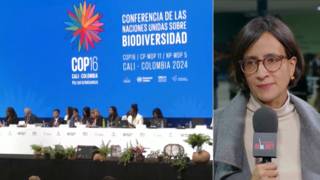
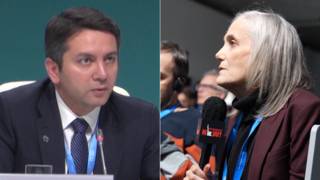
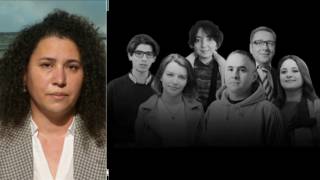






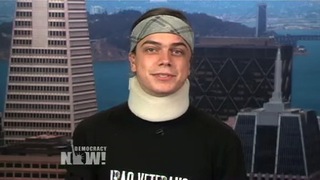
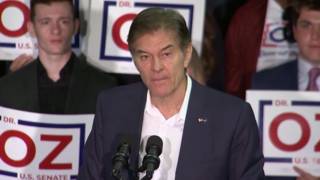
Media Options